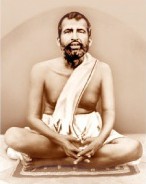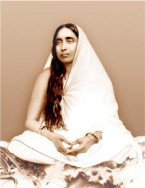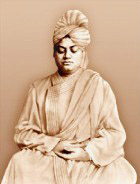Read More
“We are the servants of that God who by the ignorant is called Man.” -Swami VivekanandaRead More about The Holy Trio
Sri Ramakrishna

India, with her wealth of spiritual tradition, has produced many spiritual giants. One such spiritual giant was Sri Ramakrishna (1836-1886). His life was a testament to truth, universality, love and purity. Ramakrishna was constantly absorbed in the thought of God. He would often go into high spiritual states where he would merge with the Infinite Reality. For him, the Vedantic teaching of unity of all existence was more than theory; he literally saw, and knew, this to be true.
In his thirst for the divine, Ramakrishna followed different religious paths including various branches of Hinduism. Not content to stop there, however, he also practiced Islam and later meditated deeply on Christ, experiencing the same divine Reality through these non-Hindu paths. Thus, he came to the conclusion, based on his direct experience, that all religions lead to the same goal. In addition, through his many Sikh devotees, he learned of their faith and its great founders, and he was told of the wonderful life and teachings of the Buddha. This exposure to Sikhism and Buddhism further confirmed his experience of the universality of spiritual truth.
Ramakrishna’s love for humanity was limitless. He often said human beings were the highest manifestations of God. His disciples saw this love firsthand, and the monastic order Ramakrishna inspired achieved the distinction of being the first order in India to serve humanity. Service to God in humankind is one of the foremost ideals of the Ramakrishna Order.
Among his many other noteworthy characteristics were his universality and childlike purity, his intense sincerity, his vast knowledge of things spiritual and human (which came not from book-learning but from direct perception), and his extraordinary power to transform lives.
Ramakrishna’s teachings regarding the highest truths of spiritual life were delivered in the simplest language and were punctuated by parables and homely metaphors as illustrations. Many noted writers and philosophers—Mahatma Gandhi, Leo Tolstoy, Aldous Huxley, Christopher Isherwood, Thomas Merton, Arnold Toynbee, Joseph Campbell—have been deeply impressed and influenced by him.
Sri Sarada Devi
 The affectionate term “Holy Mother” refers to Sri Sarada Devi (1853-1920), Ramakrishna’s wife and spiritual counterpart. According to the custom then prevalent in India, she was betrothed to him while still a child. At the age of 18, she left her parental home to join her husband, who lived some sixty miles away, near Calcutta.
The affectionate term “Holy Mother” refers to Sri Sarada Devi (1853-1920), Ramakrishna’s wife and spiritual counterpart. According to the custom then prevalent in India, she was betrothed to him while still a child. At the age of 18, she left her parental home to join her husband, who lived some sixty miles away, near Calcutta.
Swami Vivekananda
 Swami Vivekananda (1863-1902) was the foremost disciple of Sri Ramakrishna and a world spokesperson for Vedanta. His lectures, writings, letters, and poems are published as The Complete Works of Swami Vivekananda. He felt it was best to teach universal principles rather than personalities, so we find little mention of Ramakrishna in the Complete Works.
Swami Vivekananda represented Hinduism at the first World Parliament of Religions in Chicago in 1893 where he was an instant success. Subsequently he was invited to speak all over America and Europe. He was a man with a great spiritual presence and tremendous intellect.
Most of the Vedanta Societies which were founded in America and Europe up through the 1930s can trace their origins directly to Vivekananda or the people who heard him speak from 1893 through 1900.
After his first visit to the West, Swami Vivekananda returned to India and founded the Ramakrishna Order in 1898.
Swami Vivekananda (1863-1902) was the foremost disciple of Sri Ramakrishna and a world spokesperson for Vedanta. His lectures, writings, letters, and poems are published as The Complete Works of Swami Vivekananda. He felt it was best to teach universal principles rather than personalities, so we find little mention of Ramakrishna in the Complete Works.
Swami Vivekananda represented Hinduism at the first World Parliament of Religions in Chicago in 1893 where he was an instant success. Subsequently he was invited to speak all over America and Europe. He was a man with a great spiritual presence and tremendous intellect.
Most of the Vedanta Societies which were founded in America and Europe up through the 1930s can trace their origins directly to Vivekananda or the people who heard him speak from 1893 through 1900.
After his first visit to the West, Swami Vivekananda returned to India and founded the Ramakrishna Order in 1898. 
